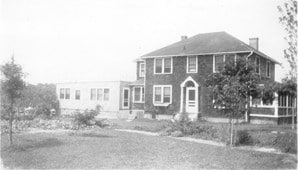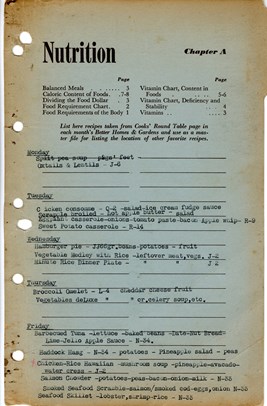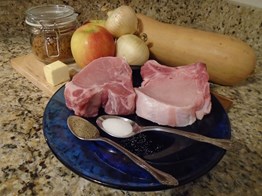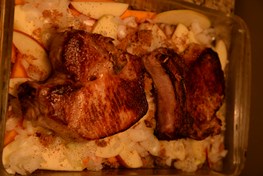Archival images copyrighted by the Edgar Cayce Foundation; other photographs by Jared Sapp
The History
Gladys Davis Turner (1905-1986) worked for Edgar Cayce while living with the Cayce family for over 20 years. In addition to her stenographic work, she assisted Edgar’s wife Gertrude with everyday household management. Resources were scarce for many years, but by the early 1940s Gladys and the Cayces lived in a modest but handsome shingled house, with a productive kitchen garden, on Arctic Crescent near the ocean in Virginia Beach.

Cayce home on Arctic Crescent, 1940.
When America entered the Second World War at the end of 1941, it affected the Cayces like it did everyone. Gladys lived with a larger and constantly changing group of residents at the house on Arctic Crescent – members like Gina Cerminara and Lydia Schrader Gray, researching concepts from the readings and helping with office work, and servicemen’s wives renting rooms to live close to the nearby military bases. Gertrude Cayce also welcomed a constant stream of visitors from all over the country who became drawn to the work, especially after the publication of Thomas Sugrue’s biography of Edgar Cayce, There is a River.
Gladys’ personal papers, housed in the E.C.F. Archives, tell the story of this period in her life through the material she chose to preserve. For example, she kept her Better Homes and Gardens De Luxe Edition Cookbook, released in January of 1942. Its narrative voice, nutritional guidelines, and recipes reminded American readers (always assumed to be women) that their kitchens were vital components of the war effort. Better Homes and Gardens, as well as many other publishers, worked with the United States government to introduce war-time cookery and economy through the ration to the general public.
The language of Gladys’ cookbook reflects this partnership between government and publisher to influence the American population’s response to the crisis. The Nutrition section informs the home cook that “your well-fed family is a tough link in civilian morale. Your war job is the building of a healthy, happy family…Make downright certain they’re getting these must-for-health foods everyday.”[1]
According to the cookbook, health and harmony were maintained by following “Your Government’s Nutrition Yardstick,” dietary guidelines suggested by the U.S. government in partnership with other organizations, such as the Committee on Food Habits, the War Food Administration and the Office of Price Administration.[2]
I was interested in comparing these with the Cayce readings’ dietary suggestions[3] to see if they shared any similarities. I found that both advocate for eating fresh produce seasonally and from local sources. The government’s Victory garden program inspired thousands of households to grow their own produce, something that the Cayces had been doing for years. The cookbook advocates for a much greater amount of dairy consumption per week. According to the Cayce data, one should enjoy dairy up to three times a week. By contrast, the cookbook recommends a quart of dairy a day for children and expectant new mothers, and a pint a day for the rest of the population. The cookbook also recommends a far greater percentage of meat for daily consumption compared to the Cayce data. Both prefer whole grains and cereals, but the readings recommend avoiding the white flour and refined grains encouraged by the cookbook (published when new methods of grain enrichment were being introduced to the mass market).
Furthermore, the chaotic yet team-oriented environment of the Cayce household during the war years resonates with the cookbook’s acknowledgement of war work’s disruption of peace-time routine:
“Perhaps you have new meals to fit into your schedule – and your budget. Some member of your family may be carrying a lunch box for the first time, or there may be an “extra” meal to plan for. It’s up to Mother to adjust everyone happily and healthfully to the new living plan…Family mealtime chatter does much for the spirits of the odd-shift worker.” [4]
The influx of requests for readings prompted Edgar Cayce to hire more office help and entertain many people who traveled to Arctic Crescent hoping for a chance to get a reading in-person. Gertrude, Gladys, and the A.R.E. members who helped with marketing and cooking had to plan wisely when mealtimes and the number of diners were often uncertain.
Gladys typed one weekly meal plan into the front page of her cookbook.

She also kept notes on her own readings’ suggestions for a healthy diet, so I assume the recipes listed coincide with both the readings’ advice and her personal taste. After researching so much about food during the writing of this blog post, and getting hungrier by the minute, it became clear that I had to try one of Gladys’ favorites for myself.
I cooked one of Gladys’ meal plan recipes with the aid of A.R.E. Conference Registrar Jared Sapp (with whom I have an acquaintance).
The Recipe
Baked Squash and Pork Chops (cost of ingredients about 61 cents in 1942)
- 4 shoulder pork chops
- 2 tablespoons butter or margarine
- 2 medium acorn squash
- 2 apples
- 2 slices onion
- 4 tablespoons brown sugar [5]
- Salt and pepper

Start your oven at 350℉ or moderate. First, brown chops in melted butter or margarine. Remove chops, add ½ cup water (to use later.)
Peel squash, remove seeds, slice into thin slices. Slice apples thin; chop onions fine. Put layer of squash in a medium casserole, then a layer of apples, half the onions, half the sugar, pork chops, salt and pepper. Add layers of remaining ingredients, moisten with meat broth. Bake 1 ½ hours, tightly covered. Serve to four.
We made three minor changes to the recipe, two intentional and one accidental. We used two pork chops instead of four. We couldn’t find an acorn squash, but made do with an unnaturally large butternut squash that did not require seed removal. I misread the amount of onions and thus used two entire onions instead of the aforementioned two slices.
The pork chops hit the pan with a dramatic sizzle. It took no time at all for the chops to brown in the crucible of hot cast iron containing a respectable layer of butter. I took them out of the pan, set them aside, and as I poured water into the pan it hissed and steamed like I was a blacksmith plunging hot metal into a bucket.
I layered the squash, apples, onions etc. that Jared had sliced along with the pork chops in our largest casserole dish. The drippings and water made a thick sauce to pour on top of everything. I covered the dish tightly in foil, and announced to Jared’s dismay that it would be an hour and a half before we would eat dinner that night.
The wait was worth it – the combination of pork chops, apple and squash with the brown sugar sauce was delicious.

The objects of everyday that wind up in archives receive a second life beyond their original role in our lives. Gladys used this cookbook to feed herself, her family members, and her extended A.R.E. family. She wrote notes, in it, pasted favorite recipes she’d found in it, took it from the Cayces’ kitchen to her own home, Glad Niche, in 1950. However, its presence in the archive transmutes it from an ordinary object to a resource of study. It is a time capsule for a specific historical moment. The field of material culture and social history, especially in the last 40 or so years, has been built upon noticing the ordinary. Through this lens, we can perceive historical figures, like Gladys and the Cayces, as the real people that they were.
Have you ever cooked a historical recipe? Were you inspired to make Gladys’ pork chops?
Let us know!
[1] Better Homes and Gardens De Luxe Edition Cookbook (Des Moines, IA: Meredith Publishing Company, 1942), A1.
[2] Jessica J. Flinn, “World War II Cookbooks: Rationing, Nutrition, Patriotism, and the Citizen Consumer in the United States and Great Britain,” Elements 3, no. 1 (2007): 79.
[3] I referenced the Edgar Cayce Basic Diet Chart, published by the Association for Research and Enlightenment Press.
[4] Better Homes and Gardens De Luxe Edition Cookbook (Des Moines, IA: Meredith Publishing Company, 1942), A4.
[5] Ryan Mair, “A Guide To The World War II Sugar Rationing Pamphlets, 1941-1945,” Special Collections, Virginia Tech, September 2015, accessed February 13, 2020,
(https://ead.lib.virginia.edu/vivaxtf/view?docId=vt/viblbv01813.xml. The Better Homes and Gardens De Luxe Cookbook was published on the eve of rationing in the United States – the government would officially establish the ration on April 27, 1942 and it remained in effect until 1946. The butter / margarine and sugar in this recipe would have been available in very limited amounts and obtainable with ration points calculated according to household.
